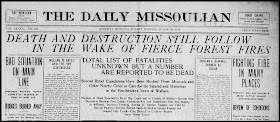 |
| The Daily Missoulian, August 22, 1910 |
The massive forest fires of 1910 were vividly reported in Montana newspapers. The headlines of late August 1910 tell the devastating story of lives lost and towns ruined across Washington, Idaho, and Montana. Gale force winds whipped the fire into a vicious storm on August 20-21, 1910, but blazes continued to do damage through the end of August. In fact, one source notes that “as late as February 1911, a ranger reported finding still-smoking snags sticking up through five feet of snow in the Clearwater country.”* Known as "The Big Blowup,” this series of deadly fires permanently changed the way people viewed forest fires and began a conversation about how they should be fought. The decisions made in the wake of the fire have influenced forest-management policies to the present day.
To read more about the fires of 1910, visit Chronicling America or view a short video on Beartooth NBC. The story is also told in Timothy Egan’s The Big Burn: Teddy Roosevelt and the Fire that Saved America.
* The Big Burn: The Northwest's Great Forest Fire of 1910, by Don Miller and Stan Cohen, Pictorial Histories Pub. Co. (Missoula, Mont.), 1993.
To read more about the fires of 1910, visit Chronicling America or view a short video on Beartooth NBC. The story is also told in Timothy Egan’s The Big Burn: Teddy Roosevelt and the Fire that Saved America.
* The Big Burn: The Northwest's Great Forest Fire of 1910, by Don Miller and Stan Cohen, Pictorial Histories Pub. Co. (Missoula, Mont.), 1993.

